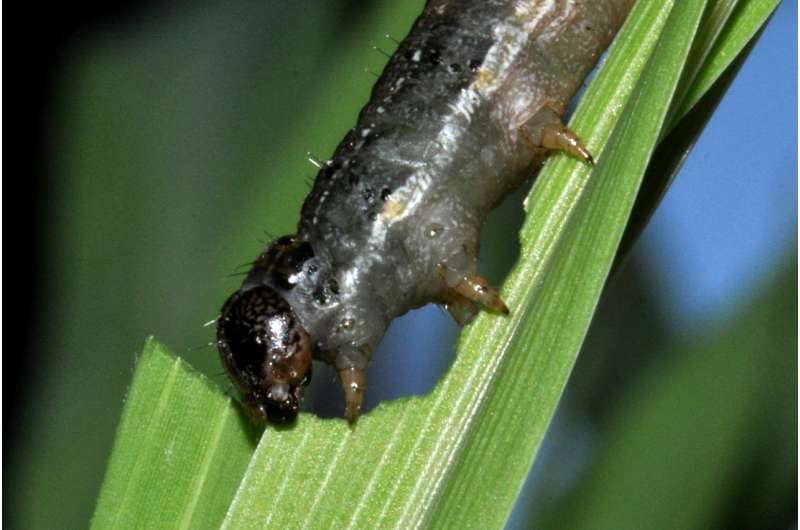Chenille. Credit: CEA
As part of an international consortium, INRA researchers, in partnership with the CEA and INRIA , have sequenced one of the first genomes of a moth from the superfamily Noctuoidea: Spodoptera frugiperda, or armyworm. This crop pest – until now only known on the American continent – has become invasive in Africa since 2016. Published in Scientific Reports on 25 September 2017, this study opens up perspectives for new methods of biological control and a better understanding of the mechanisms involved in the appearance of pesticide resistance.
Spodoptera frugiperda is a moth belonging to the superfamily Noctuoidea. It is also called Armyworm because the caterpillars are sometimes so numerous that they form "carpets" on the ground, similar to an army on the march. Unlike the majority of herbivorous insects, the Armyworm is highly polyphagous: it attacks over one hundred plant species, including crops (maize, rice, sorghum, cotton and soybean). The moth moves in large swarms and is able to fly long distances.
Until now limited to America and the Caribbean, Spodoptera frugiperda is estimated to cause 600 million dollars in damage in Brazil every year according to the FAO. In America, 67 cases of insect resistance to pesticides have been identified to date, illustrating the difficulty of controlling these populations. Since January 2016, it has become invasive in Africa, where it destroys maize crops in 21 countries in the south and west parts of the continent. It is currently a threat to the European continent.
Sequencing of one of the first genomes of a moth belonging to the superfamily Noctuoidea
In the framework of an international public consortium called Fall Armyworm, INRA researchers, in partnership with the CEA and INRIA, sequenced the genome of Spodoptera frugiperda. They described one of the first genomes of a moth belonging to the superfamily Noctuoidea and, more specifically, studied three types of gene families in this insect.
- Scientists first analysed a group of genes involved in the recognition of host plants which allows them to feed or lay their eggs. By comparing the genome of S. frugiperda with the available genomes of (non-polyphagous) Lepidoptera, researchers found an expansion in the number of genes (230 versus 45 to 74 in other Lepidoptera) encoding a certain type of taste receptor. The latter are located on the moth's trump (proboscis) or under their legs. They are thought to allow them to detect toxins or bitter compounds produced by plants. The only insect known to have such taste receptor expansions is an omnivorous beetle, the red flour beetle, which also attacks a wide range of foods.
- Researchers also looked at other families of genes necessary to cope withr the chemical defences that plants overproduce when they are attacked (detoxification). They discovered expansions in two of the four major gene families for detoxification (encoding cytochrome P450s (CYP) or glutathione-S-transferases (GST)). These are the same genes that can be involved in resistance to pesticides.
- Lastly, scientists described a group of genes involved in the digestion of plant tissues.
For the purpose of the study, two genomes of S. frugiperda were analysed: two genomic variants based on the insect's host plant – the maize variant and rice variant, which are found throughout their range of distribution in America. The researchers found differences between the variants in terms of the number and sequence of genes necessary to detoxify the toxins emitted by the plants and in the genes necessary for digestion.
This data was made available to the international scientific community to allow specialists to identify which variant of the moth is invading Africa. Moreover, this work will also make it possible to envision new biological control methods. It will also improve understanding of the mechanisms by which pesticide resistance appears.
More information: Tingcai Cheng et al. Genomic adaptation to polyphagy and insecticides in a major East Asian noctuid pest, Nature Ecology & Evolution (2017). DOI: 10.1038/s41559-017-0314-4
Journal information: Scientific Reports , Nature Ecology & Evolution
Provided by CEA























